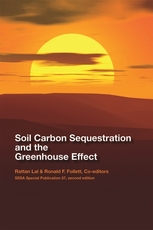Mar 9 2009
As the severity of climate change increases with each passing year, researchers continue to study the ways that greenhouse gases are released into the atmosphere. Developing methods of sequestration for carbon emissions is essential to reducing this greenhouse effect, and the role of soils as carbon sinks may determine policies in the future. A new book published by the Soil Science Society of America (SSSA), titled, Soil Carbon Sequestration and the Greenhouse Effect: Second Edition, addresses this topic and provides new perspectives as the field of carbon sequestration advances.
 Soil Carbon Sequestration and the Greenhouse Effect: Second Edition
Soil Carbon Sequestration and the Greenhouse Effect: Second Edition
The soil carbon pool has been a significant source of atmospheric carbon throughout history. As a major component of the global carbon cycle, soils are often overlooked in comparison to fossil fuel emissions. But the soil carbon pool has many effects upon the environment, including filtering pollutants from water, regulating the quality and productivity of soil, and promoting the species diversity of soil flora and fauna.
Soil Carbon Sequestration and the Greenhouse Effect: Second Edition addresses new and emerging topics within this field for professionals, offering comprehensive evaluation and modeling of key processes that control soil carbon dynamics under a range of different conditions. For soil scientists interested in actively combating global warming, this understanding of the soil carbon pool is essential to moving forward. In addition, the information presented about the carbon sink capacity of soils is also important to the future of production agriculture and global food security.
The first edition of Soil Carbon Sequestration and the Greenhouse Effect was published in 2001 by SSSA. That edition represented a breakthrough in science’s understanding of soil’s role in carbon sequestration. The second edition presents updates of new and emerging concepts of processes and properties within the field. Each chapter presents original contributions by both authors of the first edition and new invited authors.
Soil Carbon Sequestration and the Greenhouse Effect was edited by Rattan Lal, the Ohio State University, and Ronald Follet, USDA-Agricultural Research Service, Fort Collins, CO.
The primary geographical focus of the book is North America, with many of the chapters focused on the United States. Chapter titles include, “Management of Dryland Cropping Systems in the U.S. Great Plains,” “Influence of Management on Soil Organic Carbon Dynamics in Northern Mixed-Grass Rangeland,” and “Crop Residue Management and Soil Carbon Dynamics.”
The book’s content is not limited to the U.S., however, as some of the key chapters cover research done in regions of Mexico and Canada. Two chapters that demonstrate this geographic diversity are titled, “Soil Carbon Sequestration in Different Ecoregions of Mexico” and “Modeling Soil Organic Carbon Change in Canadian Agroecosystems”.
Future understanding of soil carbon sequestration will create numerous benefits for agriculture and the environment, and Soil Carbon Sequestration and the Greenhouse Effect: Second Edition is a continuation of the understanding of these processes.
View the table of contents for Soil Carbon Sequestration and the Greenhouse Effect: Second Edition at: https://portal.sciencesocieties.org/Downloads/pdf/B60917.pdf
Soil Carbon Sequestration and the Greenhouse Effect: Second Edition can be purchased online through SSSA for $70, Item No. B60917 at: www.societystore.org.